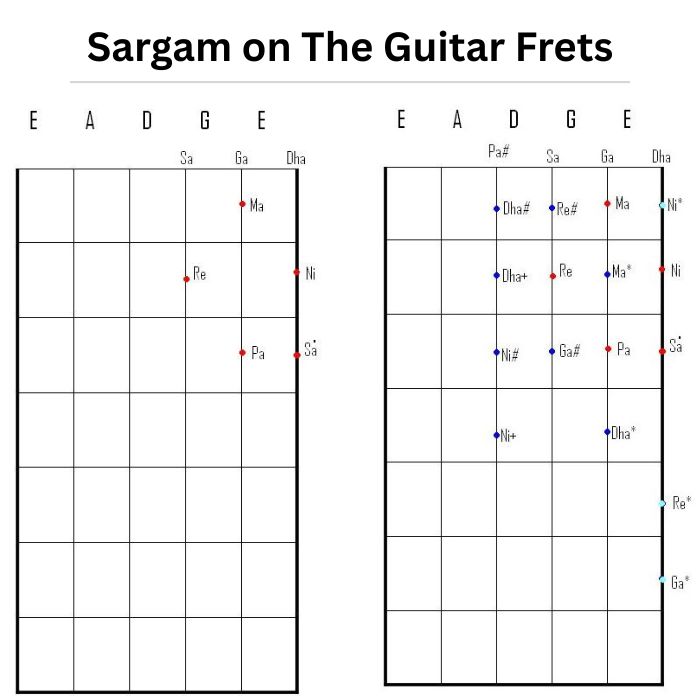Sargam on Guitar:

Image above shows the position of sargam on guitar fret boards. Imagine sargam as a set of musical “steps” (Sa, Re, Ga, Ma, Pa, Dha, Ni) that you can climb on your guitar. To play them, you need to know where those “steps” are on the guitar’s neck.
Sargam is the foundational system of musical notation in Indian classical music, serving as a vocal exercise and a melodic framework. Instead of a fixed pitch system, it employs syllables to represent the seven core notes of a musical scale.
These syllables are:
- Sa: The tonal center, analogous to “do” but movable.
- Re: The second note.
- Ga: The third note.
- Ma: The fourth note.
- Pa: The fifth note.
- Dha: The sixth note.
- Ni: The seventh note.
Musicians utilize sargam for:
- Vocal warm-ups and technical practice.
- Constructing and improvising melodic passages.
- A pedagogical method for music education.
Unlike the fixed “do-re-mi” (solfège) of Western music, where “do” has a defined frequency, “Sa” in sargam is a relative pitch. This means the musician can assign “Sa” to any desired starting note, allowing for flexibility across different scales and ragas.
In essence, sargam is a vital tool for navigating and expressing the nuances of Indian classical melodies, providing a structured yet adaptable method for musical practice and performance.
Play Sargam on Guitar:
How to play sargam on Guitar?
- “Sa” is your starting point: Pick any guitar fret on any string to be your “Sa.” This is like choosing where you want to start climbing.
- Each fret is a small step: Moving one fret up or down changes the pitch of the note.
- Find the other “steps”: The other sargam notes (Re, Ga, etc.) are at specific fret positions relative to your “Sa.” You have to know the notes on the fretboard, or learn scale patterns, to find the correct locations for these steps.
- Climb the steps: Once you know where the sargam notes are, play them in order.
Think of it like this: You’re translating the Indian musical language of sargam into the guitar’s language of frets. It takes practice to know where each “step” is, but once you do, you can play sargam melodies on your guitar.
You may also like:
- Intervals in guitar notes
- List of Major Scales in Guitar
- Slide, bend, Hammer-on, Pull-off and Tapping in Guitar
- Pentatonic Scales and Pentatonic Forms in Guitar
- Major Scales on guitar
- Half Steps and Whole Steps on guitar
- Sharps and Flats on guitar
- How to Read Guitar Tablature – Tabs/Lead
- Tuning the Guitar – How to tune your guitar?